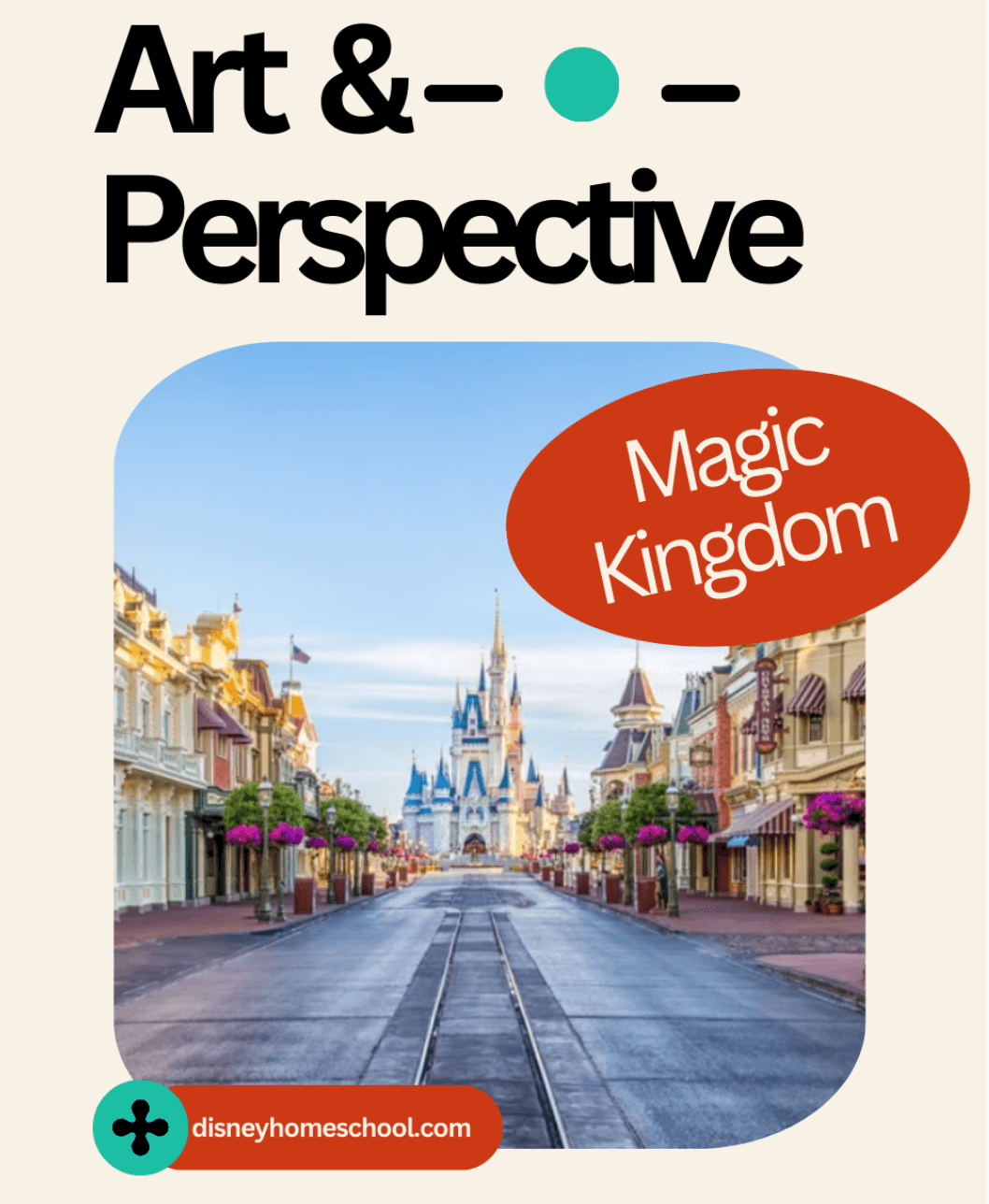How to Teach Art and Perspective at Disney’s Magic Kingdom (Main Street U.S.A.)
One of the things I love most about homeschooling is that learning doesn’t have to happen at a desk. We can take our lessons into the real world, and in our family, that often means bringing school into the Disney parks. On this particular day, I decided to plan an art lesson for my daughter all about perspective, and we based the entire thing around Main Street U.S.A. in the Magic Kingdom.
This post is a look at how we prepped for the lesson at home, what we did while walking down Main Street, and how we tied it all together with an art project when we got back. If you’re looking for a simple way to turn your park day into an educational adventure, this is one of my favorite ways to do it.
Getting Ready at Home
Before our trip, I skimmed through the Ultimate Magic Kingdom Workbook and I printed the pages we would need for Main Street USA (I used the In-Park Activity). I also created this Main Street U.S.A. perspective vocabulary worksheet to help introduce the concept of perspective (FREE printable Main Street USA Perspective Worksheet).
We started our lesson at the kitchen island by covering some vocabulary that we would experience. We focused on four important terms:
Horizon Line – where the land and sky meet
Vanishing Point – the spot where things in the distance seem to disappear
Foreground – what looks closest to you
Background – what looks farthest away
My daughter labeled the parts of the scene on the worksheet and we talked about how artists use these ideas to create depth. My daughter was already curious but then…
Discovering Disney’s Magic Trick
After we had the basics down, we talked about something extra special. I introduced her to the idea of forced perspective. Disney uses this all over the parks, and Main Street U.S.A. is one of the best examples. The first floors of the buildings are regular size, but the second and third floors are built a little smaller. This tricks your eyes into thinking the buildings are taller than they really are.
It’s the same idea used in movies, stage sets, and even photography. She thought it was so cool that artists and designers can play with what we see to change how we feel in a space. And let’s be honest, once a kid learns there’s a secret behind the magic, they’re ready to go find it themselves.
Walking Down the Middle of Main Street
When we arrived at the park, we walked slowly down Main Street U.S.A., taking our time to really look around. Instead of rushing to the rides, we made this part of the day the actual adventure. We had five questions in mind to help guide what we noticed:
What do I see first when I look down Main Street? Why does it stand out to me?
Which buildings or parts of the street feel closest? What feels farther away?
Can I find the horizon line and guess where the vanishing point might be?
How do the shapes and sizes of buildings change the farther I walk?
Now that I know about perspective, what looks different to me?
We also completed the in park activity for Main Street USA from the Ultimate Magic Kingdom Workbook here. It wrapped up the lesson nicely as we sat in the umbrella shade at Casey’s Corner.
What I loved about this part of the day was how engaged my daughter was. She wasn't just walking through a theme park. She was observing. She was thinking. She was learning, without it ever feeling like work.
Bringing It All Together at Home
Once we got home, we wrapped up our lesson by bringing out a tool that I highly recommend for any homeschool art activity: a perspective grid sketchpad. We use this one from Amazon (linked here) and it has light guide lines to help kids draw in perspective.
With everything still fresh in her mind, my daughter created her own Main Street scene. The guided lines made it much easier for her to draw her buildings and street in proper proportion. She was proud of what she made, and more importantly, she understood what she was doing.
This wasn’t just about art. It was about observation, attention to detail, and thinking like an artist. It was a memory tied to learning, and that’s what makes homeschooling feel so rewarding.
Why This Worked for Us
Not every lesson needs a stack of worksheets or a full curriculum. Sometimes, all you need is a good theme, a real-world connection, and a place to explore. By focusing on perspective and tying it to Main Street, we gave one art concept depth, meaning, and magic.
The vocabulary came alive when she saw how Disney used it. The worksheet became real when she stood at the edge of the street and could point to the horizon line herself. And the sketchpad became a tool for expressing what she experienced.
For us, that’s the best kind of homeschooling day.
Want to Try This Too?
Here’s everything we used to make our Main Street art lesson come together:
Ultimate Magic Kingdom Workbook – print the Main Street U.S.A. section to guide your in-park learning
Main Street Perspective Worksheet – free printable for learning vocabulary
Perspective Grid Sketchpad – great for helping kids draw in perspective
I’d love to hear if you try this with your family. Tag me on Instagram @homeschool.disney or leave a comment on the blog. Let’s keep making learning magical together.
Other Blog Posts You May Enjoy:
Liberty Square and a Free Printable
EPIC Theater Day at Hollywood Studios








